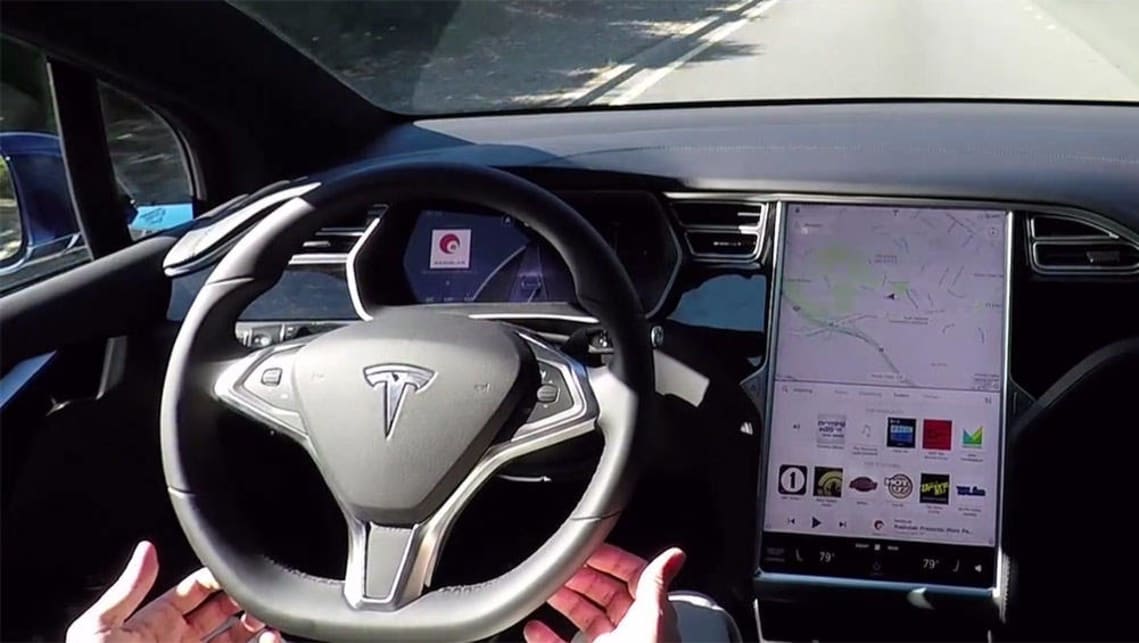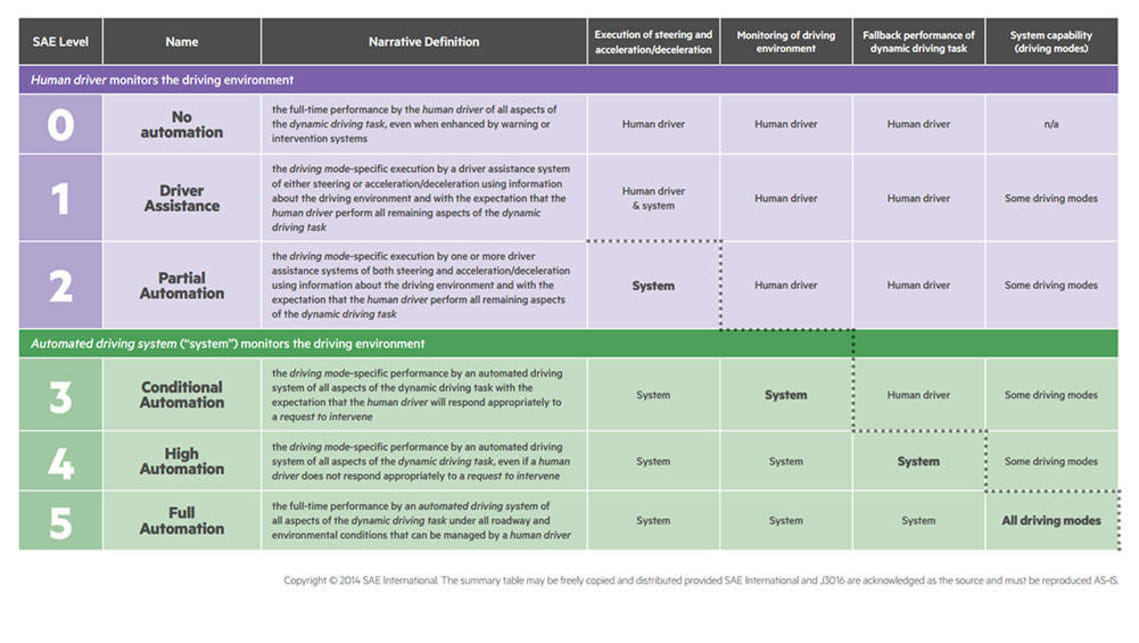
Autonomous driving levels explained
- Audi
- Ford
- Lexus
- Mercedes-Benz
- Tesla
- Volkswagen
- Urban Hacks
- Audi Advice
- Ford Advice
- Lexus Advice
- Mercedes-Benz Advice
- Tesla Advice
- Volkswagen Advice
- Technology
- autonomous
- Urban
- Hacks

Did you know that self-driving cars are split into five different levels of automation? Who decides on these levels and why?
Autonomous driving is here, but you’re not allowed to use it yet. While the automotive world surges ahead with the technology, policy and law lag behind.
Ford, BMW, Audi, Mercedes-Benz, Toyota, the Volkswagen group and especially Tesla have already thrown their hat in the ring, with most of these brands continually competing for the most ambitious autonomous driving claim.
For example, the Tesla website now states the wildest claim yet: “All tesla vehicles produced in our factory, including the Model 3, have the hardware needed for full self-driving capability at a safety level substantially greater than that of a human driver.”
However, not all autonomous cars are the same.
Vehicle autonomy has been split into five levels by the Society of Automotive Engineers (SAE) for the purpose of evaluating self-driving vehicles. While not an official regulatory body, the SAE hopes to guide future government policy on the issue.
Levels 0–2
Level 0 refers to cars with the traditional spectrum of driver inputs, from a Model T Ford to a brand-new Corolla. So no autonomous drive characteristics. The SAE call this “Full driver input on the actual act of driving.” Common active safety features such as AEB, warning instruments and radar cruise control (on its own) do not count as autonomous features.
The new Mercedes-Benz E-Class achieves Level 2 autonomy with its “Drive Pilot” autonomous cruise control feature
Levels 1 and 2 are “driving-mode specific” autonomous features that assist in steering, acceleration and deceleration.
Level 1 can be thought of as radar or active cruise control working in conjunction with lane guidance. These features are currently fitted to many existing cars including most Subaru and Mazda models and an increasing number of Europeans.
Level 2 is more advanced, where the computer controls most of the driving experience. The new Mercedes-Benz E-Class achieves Level 2 autonomy with its “Drive Pilot” autonomous cruise control feature. This will steer, keep lanes and change lanes safely with only prompts (indicator stalk, cruise control buttons) from the driver. Should the driver disengage from the wheel at any time the vehicle will come to a complete stop. In a nutshell, you need to keep your hands on the wheel in readiness to take over.
Levels 3–5
This is where things get more interesting.
The key defining factor the SAE use to split Levels 0-2 from 3-5 for is whether the car is capable of ‘monitoring the driving environment.’ – That is, where the computer is in control of all the main driving functions and able to respond to changing surroundings.
At Level 3 the car may drive and monitor the environment itself, but requires a human to be present to perform inputs if requested (via dashboard prompt). This means you can take your hands off the wheel and the car will continue unaided with a degree of ability to manage varying road conditions. It may need human input in emergencies or while navigating to a destination.
Beyond active cruise control, a Level 3 car is able to drive you in more complex traffic conditions than the free-flowing motorway environment required by lesser levels.
Level 4 does not require a human to input driving actions, even in an emergency. The car is able to respond to all situations on the road and guides itself via a navigation system and sensors. The autonomous functionality still needs to be activated by a human at the start of a journey and the car may request driver intervention, but does not need to depend on it.
For example, the car may ask you if you want to take an alternate route, if you do not respond in time the car will decide automatically.
Level 5 - ‘Full Automation’ – The car does not require a driver to be present at all. A driver is not required for emergencies or any guidance. The car is autonomous from the moment you sit in it, and is able to be summoned remotely to a location without any occupants. Sick of driving the kids to school? Your Level 5 car could do that for you. Scary, eh?
Tesla’s full self-driving capability claim implies that the new EVs are the first production cars capable of Level 5 autonomy.
Tesla CEO Elon Musk even tweeted: “When you want your car to return, tap Summon on your phone. It will eventually find you even if you are on the other side of the country.”
This boast has raised more than a few eyebrows worldwide.
If Tesla can do it, what’s the hold-up then?
Assuming Tesla has really has reached this point, the hindering factor isn’t simply technology. There are concerns about the consistency of road infrastructure, but the biggest challenge is that laws around the world are simply struggling to keep up.
In Australia, the law lags behind with a state-based approach. There is no national standards for road rules, however most legislation in Australia focuses around the role of the ‘driver’. At Level 3, this poses only a small problem as the driver will still have to be present at all times.
Above this level, autonomous driving isn’t specifically prohibited but the driver must be in control of the vehicle at all times, and is responsible for any disturbance caused by the vehicle’s movement. Therefore, using Level 4 and 5 autonomous assistance is technically illegal.
South Australia is the one exception, where you can apply for a conditional exemption from state road laws for autonomous vehicles. Good luck unless you’re using the exemption for technology development though.
Imagine a world where traffic jams, tailgating, road rage and finding a parking spot are things of the past.
In the US, the law tends to vary considerably between states. The definitions of ‘Autonomous’ in each state are inconsistent and straddle the SAE’s levels. California and Florida permit the operation of autonomous vehicles by valid driver’s license holders, provided the vehicle meets certain criteria. Most other states only permit autonomous driving under limited testing conditions or not at all.
European laws vary between countries. Some, like Germany allow conditional automation in certain environments, even inner-city laneways. Laws for the EU adhere to the Vienna Convention on Road Traffic 1958, which has recently been amended to allow autonomous control of a vehicle. A driver must still be present and able to override the system at any time, limiting its use to SAE Level 3.
As for manufacturer positions?
Mercedes-Benz has recently stated that in an emergency situations, their cars will prioritise the driver’s safety over pedestrians, which is an ethically challenging proposition at best.
Audi has said that they will take responsibility for the driver in the event of an autonomous accident – a broad claim that is hard to imagine in practice.
Volkswagen envisions a future where people do not own their cars but use autonomous ride-share vehicles to get around. They are touted to launch a sub-brand dedicated to this idea.
Lexus has developed a car that can navigate freeways, but has expressed concerns that without humans, cars will not be able to make dynamic decisions required for every day driving.
Ford has claimed that they will have a Level 4 autonomous ride-share fleet on the road by 2021.
Is it just “Look Mum, no hands!” or are there genuine benefits?
Imagine a world where traffic jams, tailgating, road rage and finding a parking spot are things of the past. Plus less emissions, cheaper insurance and fewer speed cameras.
Sound perfect? These are just some of the benefits of vehicle autonomy according to the Australian Driverless Vehicle Initiative (ADVI), an off-shoot of the ARRB dedicated to promoting the benefits of driverless technology in Australia.
They also spruik higher productivity (less time spent in traffic jams) and improved mobility thanks to shared parking, or a need for driver’s licenses.
So we could be looking at benefits far greater than just getting your car to do the school pick-up.












Comments